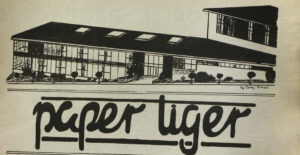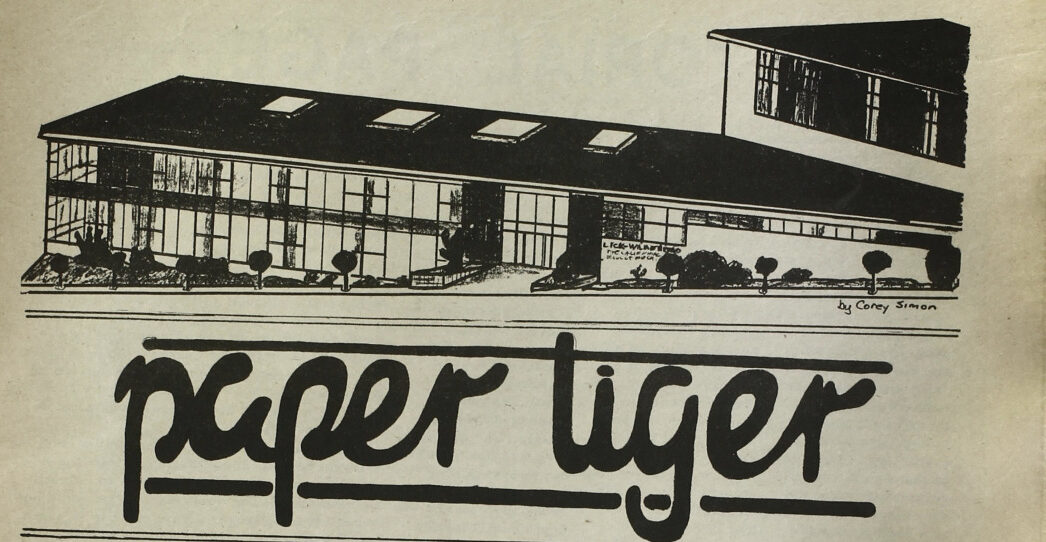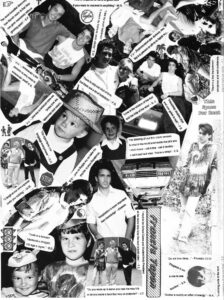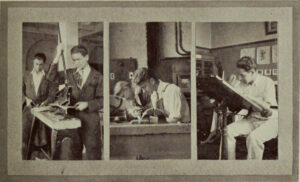
Courtesy of the LWHS Archives
Journalism and student voices have been an artery of Lick-Wilmerding High School for nearly 120 years through various publications. LWHS’ current newspaper, the Paper Tiger, has existed since 1984.

Courtesy of the LWHS Archives
In 1903, the Wilmerding School of Industrial Arts founded the Wilmerding Life and the California School of Mechanical Arts School (Lick) founded the Tiger. Both publications looked more like a zine than a typical newsprint paper. They were chatty, filled with poems, short-form journalism, jokes, drawings and many advertisements.
The Wilmerding Life was published once a month. A subscription for 6 months was 50 cents and a single issue cost 10 cents. The editorial staff was partitioned into the categories of Athletics, Alumni, Debating, School Notes, Exchanges and Jokes. The management staff was large, with seven members involved in advertisement, subscriptions, secretarial work and general business management.
In the first publication of the Wilmerding Life in December 1903, the editorial board stated its purpose: “We do not intend to have the paper made up entirely of school notes, a few joshes, and perhaps a light story or two, but we mean to make it as our name implies; we mean it shall portray the life of the Wilmerding School.” And that they did.
The Tiger was published quarterly. A subscription cost one dollar and a single issue cost 25 cents. Aside from Editor and Business Editor, there were also roles for assistant editors including school notes, exchanges, shop notes and joshes. Because of its less frequent publication schedule, The Tiger staff was much smaller than Wilmerding Life’s. The Tiger had both fewer managers and editors.
The first edition of the Tiger, published in December 1903, self-described itself: “In publishing this little paper it has been our aim to make it a factor in student affairs that will knit the student body into a more compact unit.
In 1914, the first co-issue between the Lux and Lick schools was published. These co-issues continued until the 1950s, when Lux closed permanently.
The Paper Tiger was born in 1984 and was originally overseen by English teacher and grandmother of two LWHS alums, Eleanor Burke.
From 1992 to 1996, Luke Alessandroni, current LWHS Spanish teacher, was the faculty advisor for the Paper Tiger. He had no previous experience working in journalism. He said, “Al Adams — the Head of School at the time — saw me walking down the hall and thought I looked like a newspaper writer. I had no experience in that arena.”
The paper was structured with two Editors-In-Chief, an editor for every section and around 15 additional staff writers. Five issues were published per year, with occasional special issues.
The class was run like a typical newsroom, except this one was in a LWHS classroom across the hall from the CMA room. Students polished drafts on computers, took interviews over the phone or slid across on swivel chairs to discuss with peers about upcoming articles.
Alessandroni said, “It was always a big struggle with students not wanting to go out and do the hard reporting, real journalism. They wanted to write a fantasy story about aliens landing,” said Alessandroni.
The Paper Tiger ran a column titled Dear Studs during the ’94-’95 school year when Alessandroni was the advisor. The column was run by two boys who would answer advice questions with fake answers such as “Dear Studs, I am constantly depressed and lonely. I need someone. How should I find a lover?”
Alessandroni said, “I thought it was a horrible thing to have in the paper and was just bad journalism. But it was the most popular part of the paper. So it stayed there.”
The following year, a female spin-off, Dear Totally Hot Babes, became another staple of the Paper Tiger’s monthly columns.
In 1996, Lisa Busby was hired as an LWHS English Teacher and took on the role of faculty advisor for the Paper Tiger. She had previous experience in broadcast television.
With Busby at the helm, the Paper Tiger began to go on field trips and invite in guest speakers. She ran the paper as a newsperson would. The paper still wrote playful articles, but its work was also deeply serious and professional.
Busby left LWHS in May of 1999.
Robin von Breton was then hired to lead the Paper Tiger. Von Breton had worked as a journalist, freelanced her way around the world, and started a newspaper in New Orleans with two friends from college.
“I inherited a great model for a journalism class from Lisa Busby. The class was student-run — editors led the class, ran the newsroom, helped develop the stories and edited them. Everyone learned how to engage in every level of the newspaper — including layout and publishing.
“As an advisor, I have built on that model. I found a paper that was a great deal of fun to be a part of — students were engaged in real, meaningful work — collaborating closely with their colleagues and working for a clear goal, to explore and interrogate the world around them.”
The newspaper continues to attract passionate investigators and writers driven by curiosity and integrity. Student reporters have a great excuse to reach out, talk to and network with fascinating people in all professions as they develop an array of stories — school-based, local, statewide, national and international.
A reporter gets to talk to and interview people — chess masters, CRISPR developers, sports figures, district attorneys, engineers, directors, writers, artists, leaders and common folk who they would never get a chance to talk to otherwise. Journalism expands a reporter’s perspective.
Martin Mulkeen ’01, former co-Editor-In-Chief of the Paper Tiger remembers attending a conference at the Chronicle for a day. Students met with and took workshops from staff writers and editors. They shared their experiences as journalists.
Speakers became a staple of the class. “I remember Dave Eggers came to talk to our class during a time when he was becoming a huge star for his breakout novel memoir,” said Mulkeen. The Paper Tiger continues to have professional journalists and writers speak.
The original goals of the student newspapers at LWHS remain close to the heart of the current values and purpose for the Paper Tiger.
Former co-Editor-In-Chief, William Kwok ’00, described the purpose of the Paper Tiger as twofold. “The purpose for us as staff members was to develop our reporting skills, writing skills, editing skills and teamwork skills” and to write about and inform our community. In terms of an outwardly facing purpose, Kwok said, “It was a way to communicate and to prioritize issues that we hear about at school and the greater world and develop our abilities to speak about it in a considered way —” to practice interrogating the world.
The Paper Tiger allows students to take complete ownership over their own work. “Robin gave us complete ownership of the newspaper and the mistakes we made were ours. But the triumphs we had were also ours,” said former co-Editor-in-Chief Stu Woo ’04.
When Nathan Heller ’02 was the editor, “[he] decided that all of the style guides for the Paper Tiger was completely wrong. So I wrote a new style guide. It was like 50 pages and it was extremely detailed. There were some unusual aspects of this. We did diaeresis over the repeated vowels as they do in the New Yorker.”
A significant moment in the history of the Paper Tiger was the publication of a special issue in March of 1999 in response to racial slurs written in blood across the walls of an LWHS bathroom. As the school was reckoning with the incident through assemblies and discussions, The Paper Tiger came together and published a special four-page issue titled “The Blood on the Walls.”
Kwok said, “We made the collective choice to drop everything that we were doing and collectively focus on this. It was an incredibly powerful thing to do. It was emotional stuff. Real-world stuff coming to our school.” Kwok continued, “Typically, you’re all just focusing on your piece, but this was the rare occasion where everyone began working toward the same purpose.”
During this time, the technology used by the Paper Tiger technology was changing along with the rest of the world. “We didn’t even have the paper on a file or anything. It was like a literal newspaper. We would print out formatted stories to paste together the pages and sometimes paste things on top,” said Busby. The final “camera-ready” paste-up of the pages of the paper would then be delivered to a printing house in the Mission district of San Francisco.
Mulkeen shared a story in which technological advancements played a role: “There was a small tweak in something that I’d written,” but von Breton had already delivered the pages to the printer. It was late at night so Mulkeen phoned von Breton. Von Breton quickly phoned the press. Mulkeen recalls, “I remember actually going to the place where it was printed, which was somewhere in the Mission with a CD-ROM to say, ‘Hey, Stop the presses!’” The crucial corrections were made, and the paper was printed and delivered to LWHS the next day.
Von Breton said, “In the first years I was on the paper it was very uncompetitive. It was everyone working together for the good of all, and it was a very close-knit group of people. I think that Lisa Busby really created that environment. I feel in recent years that spirit has also characterized the staff. Many friendships have been forged. Our work is very collaborative,”
In 2002, the shop’s pit was completed and the journalism class migrated from their space in the library building to the MacLab, where it remains to this day.
Woo reflected on being a publication fully funded by a school. “I can’t remember any tension between my sophomore and junior years.” He described how the Paper Tiger’s relationship with the administration went downhill after an article was written on the reason for a FacStaff member’s departure.
In response, the administration decided to drop the newspaper as an independent student publication and give it to the development office. “The kids were outraged,” said von Breton.
Von Breton was then asked to step down as the advisor from the Paper Tiger. During her six-year hiatus, Mary Rose became the faculty advisor of the paper. Von Breton continued working as an LWHS English teacher.
In 2010, under Rose’s supervision, the Paper Tiger published a racially offensive article as part of an April Fools special issue. “There was a running joke that the freshman-sophomore hallway smelled really bad. In this article, someone made a joke about how they had found dead bodies in the closet hallway,” said Emma Arnesty-Good ’12, who was a staff writer at the time.
“The student had written that the facilities manager had been taken away in handcuffs. And the facilities manager happened to be Black. It was a big deal,” Arnesty-Good said. “The satire was wickedly nasty and also very racist,” said von Breton. “A person of great integrity who worked his heart out for the students and the school was cruelly attacked.”
“There were tensions already in the faculty around race, and this turned into a very large conversation. It was the catalyst for a lot of these conversations that we had as a school about racial justice,” said Arnesty-Good.
The article sent shockwaves through the student body. Students broke up into racial affinity groups and held assemblies. Following these events, Rose was asked to leave and Von Breton returned to advise the paper in 2012.
Technology advanced rapidly throughout the 2000s which impacted the way that the Paper Tiger was able to function. Clunky Pagemaker morphed into the less clunky and now sleek and supple Adobe InDesign. In 2015, an online website was booted up and now is home to podcasts and video components, as well as special online stories and digital versions of the articles in the paper edition.
Following the Parkland Shooting in 2018, the Paper Tiger staff came together again to create a 28-page special issue that covered the massacre and the aftermath. Von Breton said, “We surveyed other school shootings and the response of communities and politicians to those. We looked at the role of guns in America. We had an in-depth article on the NRA, its origins, and its role in the history of white supremacy. We also wrote about the history of firearms companies.”
Late nights at layout seem to be a staple of working on the Paper Tiger. Woo said, “I think once we were there until 1 a.m. or something like that. It was kind of our own fault. Look, it was definitely wrong. We’re not as organized as we should have been. But it was fun. And it was all worth it. It was the beginning of my journalism career.”
In recent years, the paper has taken on a more serious tone with a focus on longer-form journalistic pieces. A year online during the pandemic inspired the Paper Tiger to publish a magazine titled 21 Places that collected articles the staff had written during the quarantine. 21 Places included articles about where around the Bay one could go hiking, run and ride bikes where one could stay safely distanced from others — and free to explore.
Since Alessandroni was the advisor, the Paper Tiger has won many Columbia Scholastic Press Association Awards — gold and silver medals. In 2019, the online Paper Tiger was a gold medalist and won the Paper Tiger’s first Silver Crown.
Von Breton will be leaving this year, and the future of the Paper Tiger lies in the hands of new LWHS English teacher, Julia Butterfield.







